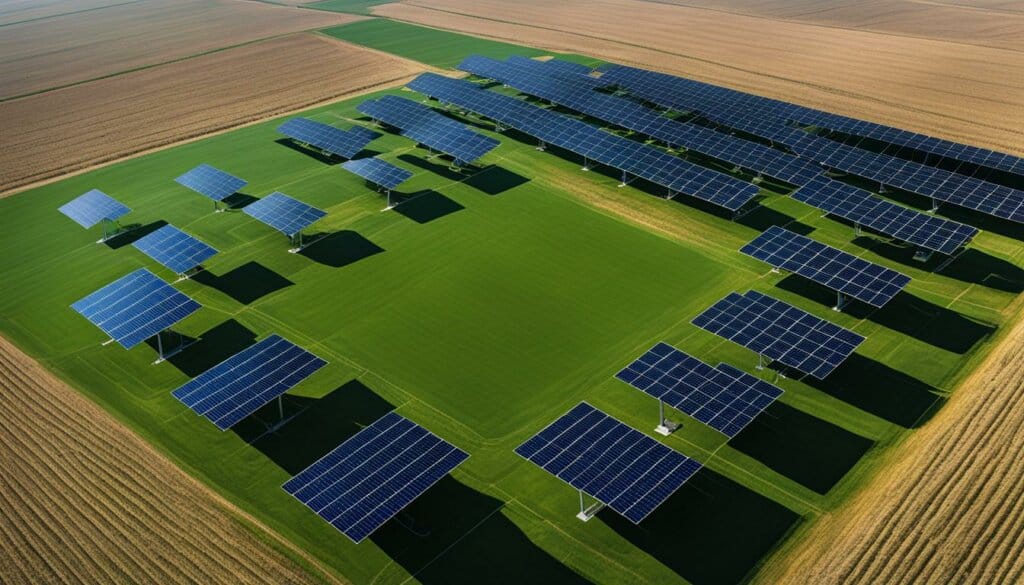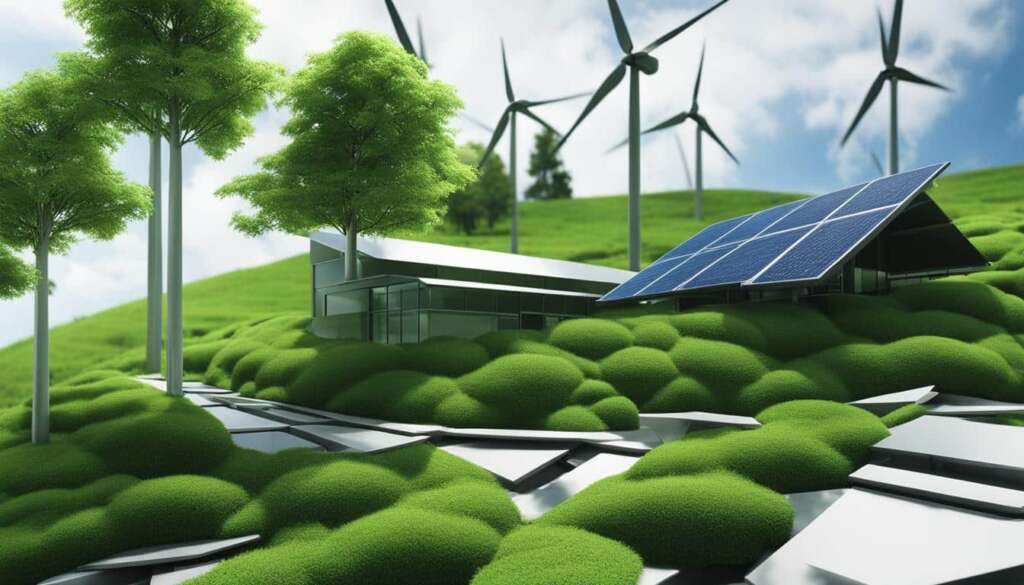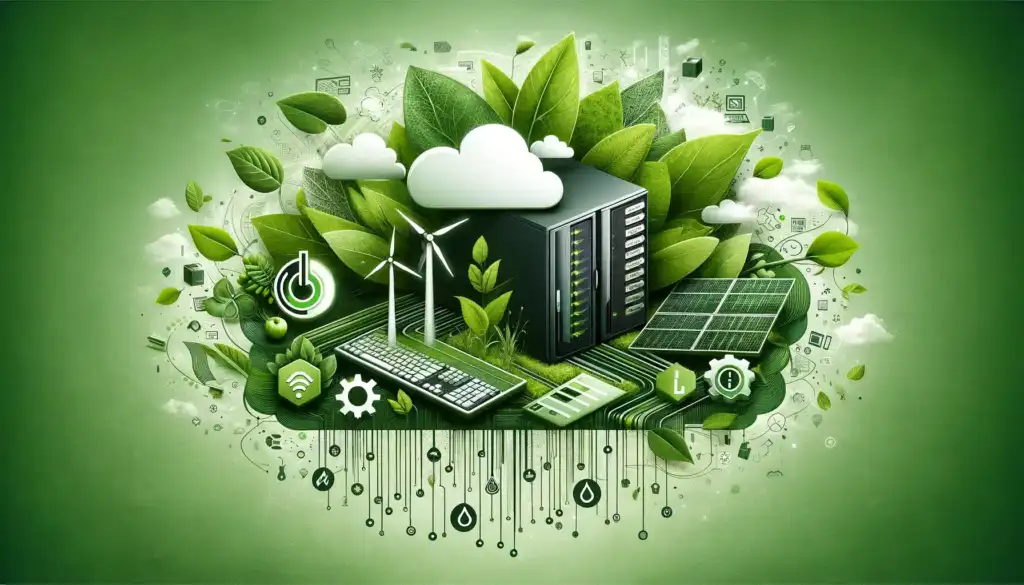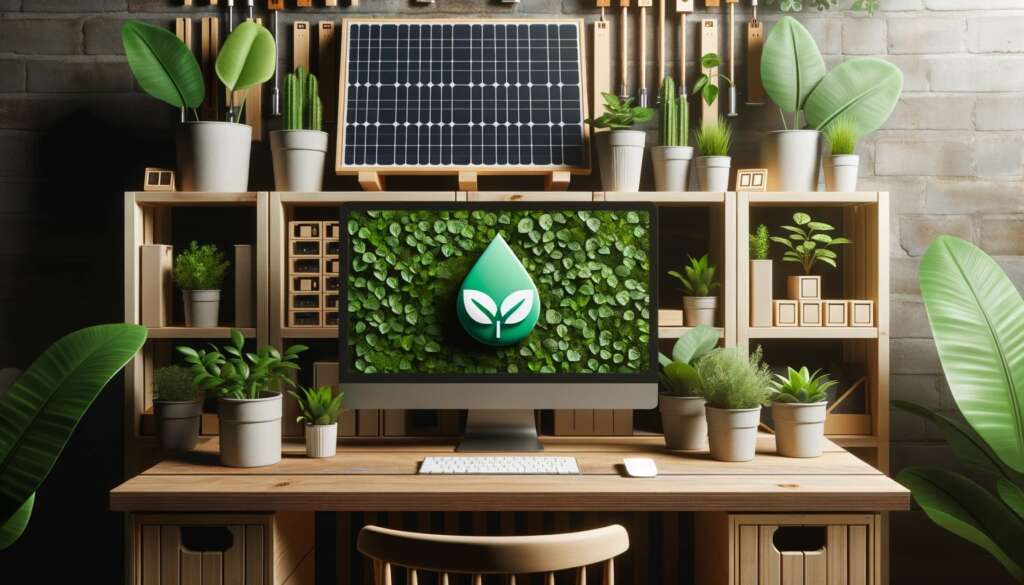Table of Contents
Green computing is a crucial component of sustainable technology and responsible computing. By implementing eco-friendly IT practices, businesses can reduce their environmental impact and contribute to a more sustainable future. Green computing encompasses a range of strategies that focus on the design, manufacture, use, and disposal of computing devices. It aims to minimize energy consumption, promote the use of renewable resources, and reduce electronic waste.
At its core, green computing seeks to optimize the efficiency and sustainability of IT infrastructure. By adopting green technology solutions, organizations can not only improve their environmental footprint but also reap numerous benefits. Green IT solutions lead to energy and cost savings, as well as reduced pollution from responsible waste management. Moreover, embracing green computing enhances a company’s corporate image, showcasing their commitment to environmental responsibility.
In this article, we will explore the key techniques and the significance of green computing, as well as the benefits it brings to businesses. Additionally, we will delve into diverse approaches and innovations in sustainable IT. Let’s embark on this journey towards a greener and more sustainable future.
Key Techniques in Green Computing
In order to achieve sustainability and reduce the environmental impact of computing devices, various key techniques have emerged in the field of green computing. These techniques focus on energy efficiency, resource utilization, and environmentally conscious production. The four main techniques in green computing are mobile green computing, green Internet of Things (IoT), green big data analytics, and green cloud computing.
Mobile Green Computing
Mobile green computing aims to design energy-efficient computing devices and minimize the use of hazardous materials. By using low-power processors, optimizing software applications, and implementing power-saving features, mobile devices can operate efficiently while consuming less energy. This not only conserves power but also extends the battery life of mobile devices, reducing e-waste in the long run.
Green Internet of Things (IoT)
Green IoT practices prioritize energy consumption reduction and environmentally conscious production. By implementing energy-efficient sensors and devices, utilizing sustainable materials in IoT hardware, and optimizing communication protocols, green IoT aims to minimize the environmental impact of IoT technologies. This contributes to a more sustainable and eco-friendly deployment of IoT solutions.
Green Big Data Analytics
Green big data analytics focuses on efficient resource utilization and infrastructure scalability for processing and analyzing large volumes of data. By optimizing algorithms, utilizing parallel processing techniques, and employing data compression methods, green big data analytics aims to reduce energy consumption and minimize the environmental footprint associated with big data processing.
Green Cloud Computing
Green cloud computing optimizes resource allocation and considers energy costs as a critical optimization parameter. By implementing virtualization techniques and dynamic workload management, green cloud computing ensures efficient utilization of cloud resources, reducing energy consumption and carbon emissions. It also promotes the use of renewable energy sources to power data centers, further enhancing the sustainability of cloud computing infrastructure.
These key techniques in green computing play a vital role in promoting sustainability and reducing the environmental impact of IT operations. By adopting these techniques, businesses and individuals can contribute to a greener and more sustainable future.
The Significance of Green Computing
As the electronics industry continues to expand, so does the production of hazardous waste, with computer waste being a prominent contributor. This waste often contains toxic substances that pose significant harm to the environment. To mitigate these challenges and foster a more sustainable electronic ecosystem, the adoption of green computing practices is essential.
Green computing encompasses a range of strategies aimed at reducing energy consumption and minimizing environmental impact throughout the lifecycle of computing devices. These practices focus on the design, manufacturing, use, and disposal of electronic products. By embracing green computing, businesses and individuals can actively contribute to the preservation of our planet’s resources and the reduction of electronic waste.

One of the key advantages of green computing is the reduction in energy consumption, which leads to lower carbon emissions and a more sustainable energy footprint. Green computing strategies have already made significant strides in this area, but continuous innovation is imperative to address emerging trends and challenges in the rapidly evolving technology landscape.
By integrating energy-efficient hardware, implementing renewable energy sources, and adopting a circular IT economy, green computing can further minimize energy consumption and contribute to a more sustainable future. Additionally, responsible disposal and recycling practices can significantly reduce electronic waste and prevent the release of hazardous substances into the environment.
Benefits of Green Computing for Businesses
Green computing offers significant advantages for businesses, ranging from energy and cost savings to enhanced waste management practices and reduced pollution. By adopting sustainable IT solutions and responsible computing practices, organizations can contribute to a greener and more environmentally friendly future.
Energy Savings
One of the key benefits of green computing is the minimization of energy consumption during IT processes. By utilizing energy-efficient hardware and implementing power management strategies, businesses can reduce their carbon footprint and realize substantial energy savings. This not only contributes to a more sustainable environment but also results in significant cost savings for the organization.
Cost Savings
Green computing practices directly translate into cost savings for businesses. By optimizing energy usage and adopting energy-efficient technologies, organizations can reduce their electricity bills and operational expenses. The savings obtained through green computing can be redirected towards other business initiatives, promoting growth and sustainability.
Recycling and Waste Management
In addition to energy and cost savings, green computing encourages the reuse and recycling of electronic waste. By implementing proper e-waste management practices, businesses can minimize the environmental impact associated with the disposal of outdated or non-functional IT equipment. Recycling electronic waste not only helps conserve natural resources but also reduces the harmful effects of hazardous materials on the environment.
Reduced Pollution
Green computing plays a crucial role in mitigating pollution and promoting responsible waste management. By adopting sustainable IT practices, businesses can minimize the release of harmful emissions and pollutants into the environment. By reducing the disposal of electronic waste in landfills, green computing helps protect ecosystems and preserve the quality of air, water, and soil.
In summary, green computing provides numerous benefits for businesses, including energy and cost savings, improved waste management, and reduced pollution. By prioritizing sustainability and embracing eco-friendly IT solutions, organizations can contribute to a more environmentally conscious and responsible future.
Diverse Approaches to Green Computing
Green computing embraces various approaches to reduce environmental impact and promote sustainability. These approaches include harnessing solar energy through solar power systems, utilizing wind turbines in wind turbine programs for electricity generation, and leveraging geothermal power for heating and cooling solutions.

Harnessing solar power is a key aspect of green computing. Photovoltaic panels capture sunlight and convert it into usable electricity, providing a renewable energy source for computing systems.
Wind turbines offer another eco-friendly solution, aligning with the principles of green computing. By using wind turbine programs, businesses can generate electricity from the power of the wind, reducing their reliance on traditional energy sources and minimizing carbon emissions.
Additionally, green computing explores the potential of geothermal power for heating and cooling purposes. Geothermal systems utilize the earth’s natural heat to provide energy-efficient climate control, reducing the reliance on electricity-based heating and cooling systems.
Innovations in Green Computing
The field of green computing is continually evolving, with various innovations driving sustainable practices in the IT industry. These advancements focus on energy-efficient hardware design, renewable energy integration, the promotion of a circular IT economy, and the development of advanced data center cooling techniques.
Energy-Efficient Hardware
Companies are investing in the development of energy-efficient hardware, such as low-power processors and power management systems. These advancements aim to reduce energy consumption and minimize the environmental impact of computing devices. Manufacturers like Intel and AMD have introduced eco-friendly processors that deliver high performance while consuming less power.
Renewable Energy Integration
The integration of renewable energy sources in IT infrastructure is a key focus within green computing. Data centers and server farms are utilizing solar power systems, wind turbine programs, and geothermal power to reduce reliance on fossil fuels. By harnessing renewable energy, organizations can significantly decrease their carbon footprint and operate in a more sustainable manner.
Promotion of a Circular IT Economy
The circular IT economy aims to minimize waste and maximize resource efficiency by promoting the reuse, refurbishment, and recycling of IT equipment. This approach prolongs the lifecycle of devices, reducing electronic waste and conserving valuable resources. Companies like Apple have implemented trade-in programs and recycling initiatives to encourage the responsible disposal and repurposing of electronic devices.
Data Center Cooling Innovations
Data centers consume vast amounts of energy, primarily for cooling purposes. Innovations in data center cooling techniques are focused on improving energy efficiency and reducing carbon emissions. Techniques such as liquid cooling, free cooling, and advanced airflow management systems are being implemented to optimize cooling processes and minimize energy wastage. This not only reduces operating costs but also contributes to a greener IT infrastructure.
The integration of these innovations in green computing is revolutionizing the IT industry, leading to more sustainable and environmentally friendly practices. By embracing energy-efficient hardware, integrating renewable energy sources, promoting a circular IT economy, and implementing advanced cooling techniques, businesses can significantly reduce their carbon footprint and contribute to a greener future.
Conclusion
Green computing is not just a passing trend; it is a vital component of sustainable IT and environmental responsibility. Businesses have a unique opportunity to embrace eco-friendly practices and contribute to a greener future. By adopting energy-efficient strategies and responsible waste management, organizations can significantly reduce their environmental impact and enhance their corporate image as environmentally responsible entities.
Green computing is more than just a buzzword; it is a critical discipline that aligns technological advancement with environmental preservation. As companies strive to meet their sustainability goals, green computing provides a practical framework for reducing energy consumption and minimizing electronic waste. By investing in energy-efficient hardware, utilizing renewable energy sources, and embracing a circular IT economy, businesses can play a significant role in creating a more sustainable world.
Moreover, green computing goes beyond the benefits to the environment. It also offers substantial financial advantages for businesses. Through energy savings and more efficient waste management, companies can experience cost savings and improved operational efficiency. By integrating green computing practices into their operations, businesses can cultivate a positive image among customers, investors, and partners who prioritize environmental responsibility. Sustainable IT is not just an ethical responsibility; it is a strategic advantage in today’s environmentally conscious marketplace.
FAQ
What is green computing?
Green computing refers to the responsible and eco-friendly utilization of computers and their resources. It involves strategies aimed at reducing the environmental impact of computing devices throughout their lifecycle, including design, manufacturing, use, and disposal.
What does mobile green computing focus on?
Mobile green computing focuses on designing energy-efficient computing devices and minimizing the use of hazardous materials to reduce environmental impact.
What is green Internet of Things (IoT) practice?
Green Internet of Things (IoT) practices prioritize energy consumption reduction and environmentally conscious production to promote sustainability.
What is green big data analytics?
Green big data analytics emphasizes efficient resource utilization and infrastructure scalability, considering energy costs as a critical optimization parameter.
What is green cloud computing?
Green cloud computing optimizes resource allocation and considers energy costs as a critical optimization parameter.
How does green computing address electronic waste?
The electronics industry contributes significantly to hazardous waste production. Green computing aims to mitigate this challenge by promoting responsible waste management and reducing the environmental impact of computer waste.
What are the benefits of green computing?
Green computing leads to substantial energy and cost savings through minimizing energy consumption during IT processes. It also encourages the reuse and recycling of electronic waste, contributing to more efficient waste management and reduced pollution.
What are the approaches to green computing?
Green computing encompasses several approaches, including harnessing solar energy through photovoltaic panels, utilizing wind turbines for electricity generation, and harnessing geothermal power for heating and cooling solutions.
What are the innovations in green computing?
Innovations in green computing include the design of energy-efficient hardware, the integration of renewable energy sources in IT infrastructure, the promotion of a circular IT economy, and the development of advanced cooling techniques for data centers.
Why should businesses embrace green computing?
Embracing green computing practices allows businesses to adopt eco-friendly strategies, reduce their environmental impact, and enhance their corporate image as environmentally responsible entities.







